Cowries of southern Sri Lanka
Author : Felix Lorenz, with Jana Kratzsch, 2000
Welcome
This site shows the results of our research carried out along the South coast of Sri Lanka between March 1998 and January 2000. The shells shown here all come from beaches and reefs between Galle and Tangalla. They were collected by local Singhalese fishermen, women and children. Most shells belong to varieties found only in the described area and are are much different from the typical forms of the respective species. To contact us, click here. Your comments are most welcome.
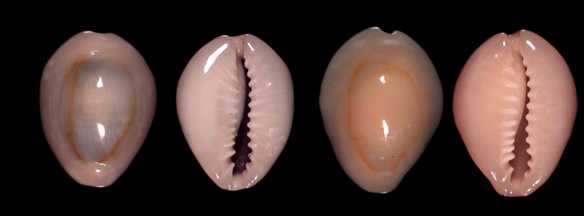
Erosaria annulus
Uncommon. This species seems to occur only spordadically. The few livecollected specimens we have seen do not differ from those of other Indopacific populations. A subfossil variant (on right) is also known from a single specimen.
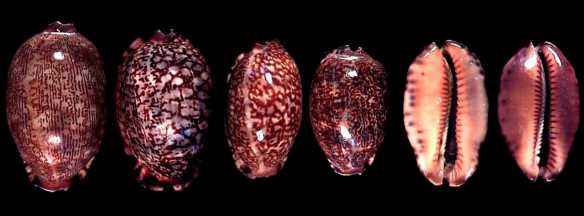
Mauritia arabica asiatica typical large form
Common. A very variable cowry whose large form is rather common in the Galle area. Occasional specimens from this spot have the pattern resembling the rare variety merguina from Birma. Some specimens have a bright purple base (specimen on right).
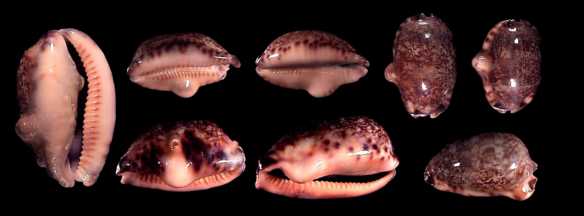
Mauritia arabica asiatica freak variety with barnacles
In Galle harbour a freak variety with encorporated and overglazed barnacles may be found. It is interesting to note that rows of analogous shells can be set up, e.g. a form with a bump (grown over barnacle) on the left margin.
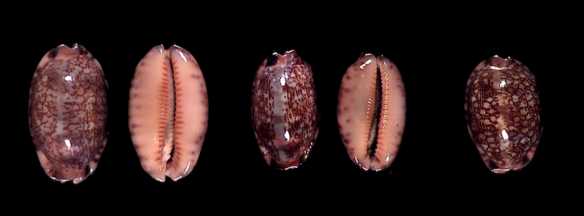
Mauritia arabica asiatica dwarf form
The dwarf form of asiatica is quite uncommon in good condition. It is found towards Weligama.
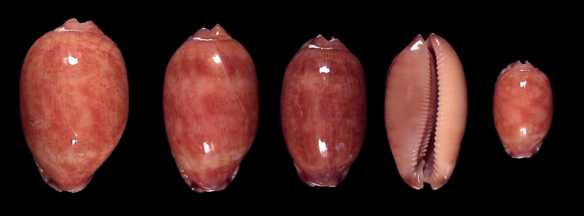
Mauritia arabica asiatica subfossil form
A spectacular subfossil form was found in deposits near the beach of Dikwella. We managed to get six specimens of this bright red, glossy form which is an outstanding contrast to the livecollected shells.
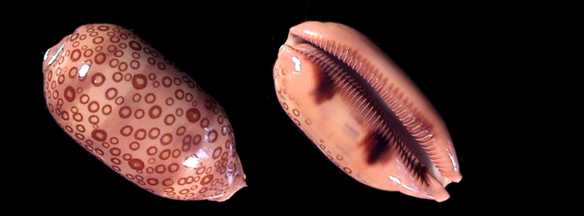
Lyncina argus contrastriata
Only one specimen of this species was bought from a fisherman who claimed to have found it near Galle Harbour. We have seen only very eroded shells on our way east. Probably, this species is very rare and lives in the deeper sublitoral.
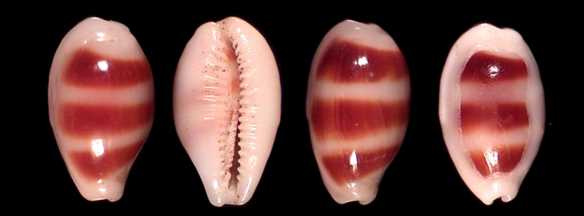
Palmadusta asellus
We have found only eroded specimens, some of which show considerable development of callus.
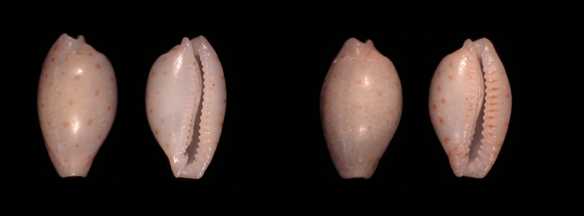
Erosaria beckii
Two very eroded but easily recognizable specimens were found amongst other beached shells from the Tangalla area. The species evidently lives here, but probably in deeper water.
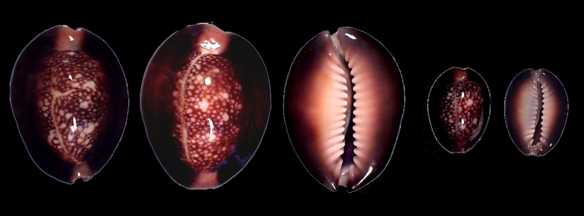
Erosaria caputserpentis typical and dwarf form (on right)
A common species in tidepools along the entire coast. There is a dwarf form from east of Galle.
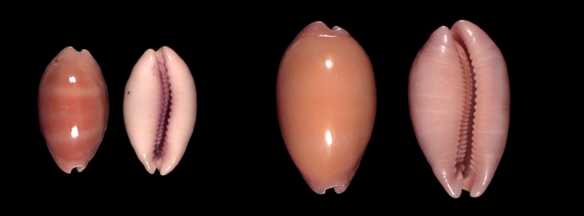
Lyncina carneola
Rare. Only a few fairly scratched specimens were found. These resemble the rostrated forms of the Arabian crassa. A single well preserved subfossil specimens was also found in the Dikwella deposits.
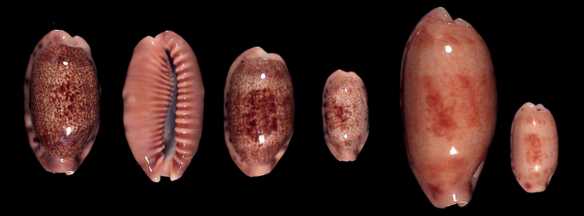
Erronea caurica dracaena
Uncommon. A variable species sporadically found along the south coast. The calloused shells resemble the variation corrosa from northern localities. There are a few spectacular subfossil giants as well as very small subfossil specimens available.
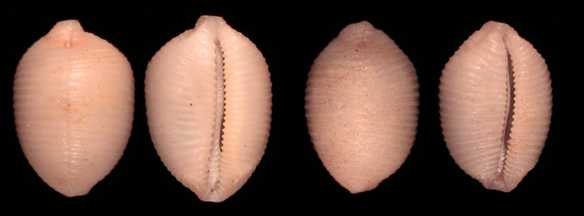
Ipsa childreni "lemurica"
Rare. Two eroded, rather large-cylindrical shells were found amongst shells from Tangalla. Apparently, the tales of the Indian-Ocean childreni are true, as these shells confirm its presence in Sri Lanka.
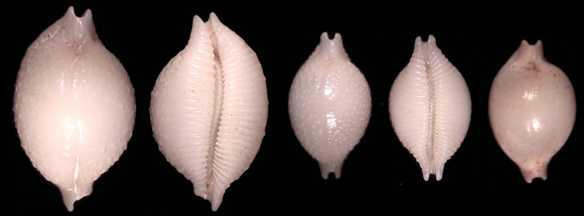
Pustularia cicercula
Uncommmon, usually found eroded and with chipped terminals. There is a very large, bulbous form from the Galle area, and smaller rostrate ones (lienardi) from further east.
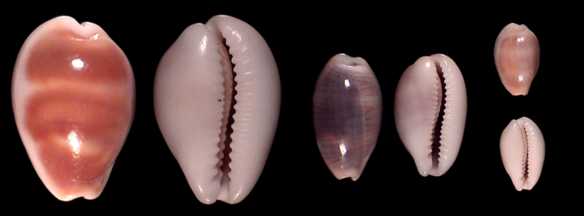
Palmadusta clandestina
Common as a beach shell but hard to find in good condition. The Sri Lanka form of clandestina differs markedly from others in the Indian Ocean by its calloused, broad shell and the short teeth. The extremities are not stained with darker as in passerina.
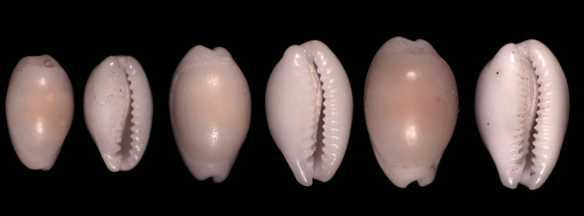
Palmadusta clandestina ???
In an area called Ahangama (near Weligama) we found a very peculiar set of shells, all measuring only between 7 and 9 mm. These extreme dwarfs are perfectly formed (no degeneration visible), with well developed dentition and extremities. They are presently under study as a possible new taxon allied to clandestina
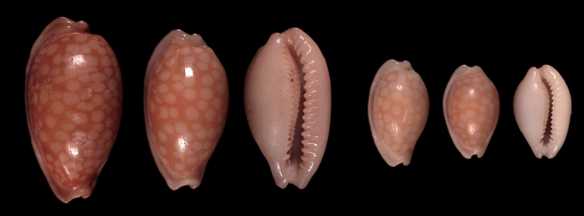
Cribrarula cribraria cribraria subfossil form
Rare. The typical cribraria must have occurred in the southern Province of the Island, but it is nowadays replaced by the more callous, often spotted cribraria ganteri. We have found a few subfossil remnants of typical, slender cribraria in the Dikwella deposits. These are sometimes in remarkable condition. There is also a dwarf form, known only from eroded subfossil examples. This form resembles closest the Micronesian gaspardi, but with still more produced labral margin. It is so far unnnamed.
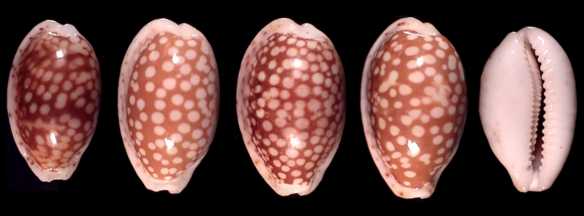
Cribrarula cribraria ganteri
Uncommon. The recently discovered cribraria ganteri has its population centre in the area we visited. It is almost exclusively found beached, but after strong stroms a fresh, gem example may wash up. There is a large, callous form (top row) with distinct marginal spots. This is usually eroded but we have a small number of good ones, too. Smaller specimens show all the characteristics of ganteri, but are far less spectacular than the giantic ones from the Weligama area.
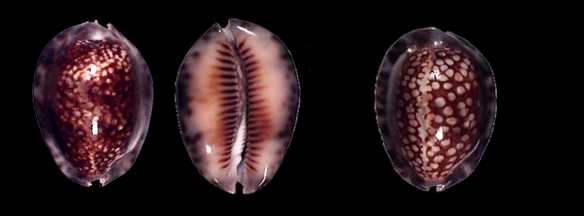
Mauritia depressa dispersa typical form
Rare. We found five specimens inbetween arabica asiatica from Galle. The species appears more common in the north of the island and does not differ from shells of other Indian-Ocean localities.
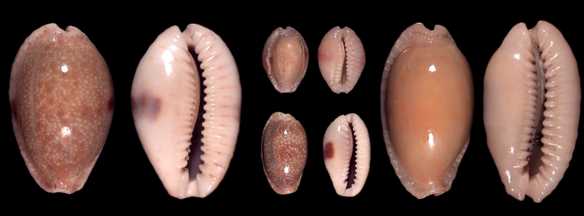
Erosaria erosa erosa
A common species found alongside ocellata, but often in deeper water. We have noted an interesting dwarf variety hardly exceeding 20 mm. The subfossil form is spectacular. there are shells with a yellow dorsum and a bluish-grey base, as well as giant specimens with corrugated labrum.
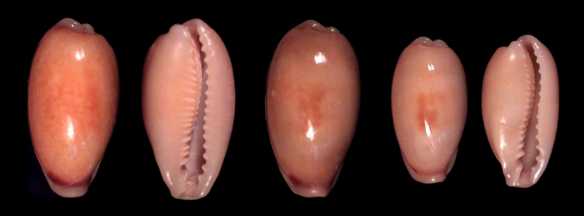
Erronea errones bimaculata subfossil form
Apparently, the species is not found along the southcoast (but it is common in the north). We have, however, evidence that it did occur there. There is a small number of shells from the Dikwella deposits. These are fully glossy and attractive. Their shape resembles the ?extinct mozambicana-population from east Africa rather than Indian shells.
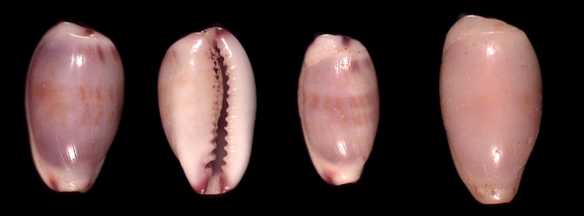
Purpuradusta fimbriata fimbriata
Apart from a few eroded beached shells we have no evidence for this species. These shells are similar to those from Thailand and India.
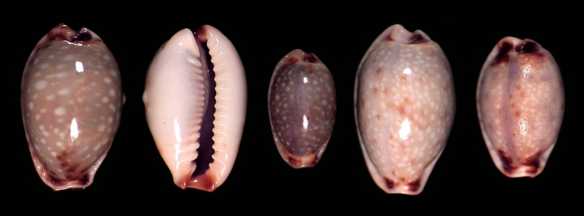
Erosaria gangranosa gangranosa
Not common as a livecollected shell. We got a few samples from the Tangalla area. These are rather sparsely spotted, the terminal blotches are separated. In one specimen, the blotches are fused (on the right) thus resembling the subspecies reentsi.
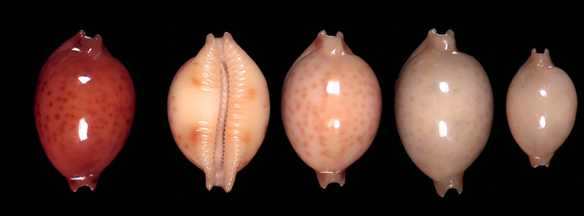
Pustularia globulus globulus typical and "yellow"
The typical deep red coloured globulus occurs all along the Sri Lanka coast and is usually found fresh beached after storms, with the animal still inside the shell. In the restricted area between Galle and Weligama, a yellow form is found. This deviates completely from all known forms of globulus and is presently under staudy. We habe two shells with remnants of the animal, and several other fresh gem specimens. It varies considerably in size and is very attractive. The "yellow" globulus is one of our most important discoveries made on this trip.
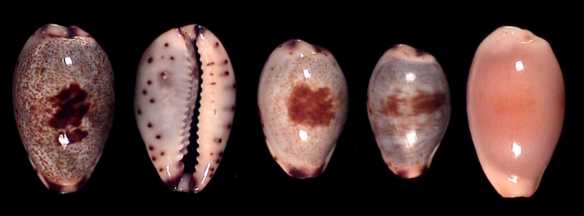
Purpuradusta gracilis gracilis
A common species found all along the coast, usually with slight erosion. Livecollected shells are very attractive. There is also a spectacular subfossil form.
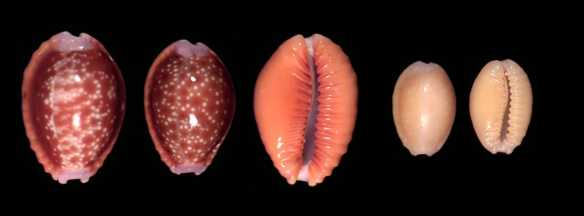
Erosaria helvola helvola
Rare, only know to us from the strip of beach facing Fort Galle. However, a dwarfed subfossil form is occasionally found throughout the south coast. This is callous and very different from the shells found alive these days.
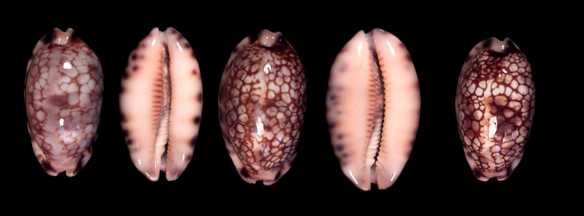
Mauritia histrio ssp. nov.
Another big surprise for us was the discovery of this dwarf population of histrio in a small village between Dikwella and Tangalla. In this isolated spot this probably new subspecies occurs in deep crevices of corals an moderately shallow water. The specimens we managed to gather are all between 33 and 40 mm, no larger shells were found. The shape is much more narrow, and the dentition differs by being short and less numerous.
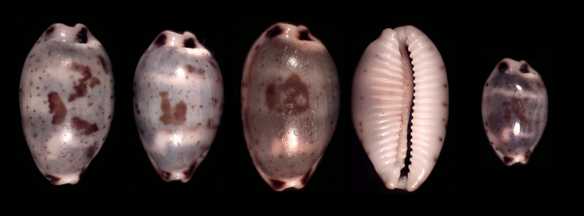
Bistolida hirundo hirundo
The typical hirundo is very common along the coast, but it is hard to get gem ones. We have hundreds of fresh beached shells but only three livecollected ones, all from Galle. The Sri Lanka hirundo is the nominate form, not differing much from Indian shells. There are, however, three forms of hirundo which are noteworthy, these are shown in the following. It is interesting that hirundo in the recent history of southern Sri Lanka has undergone a number of evolutionary changes. Perhaps the total absence of Bistolida kieneri in southern Sri Lanka has enabled the species to radiate further in various shallow water habitats otherwise occupied by kieneri.
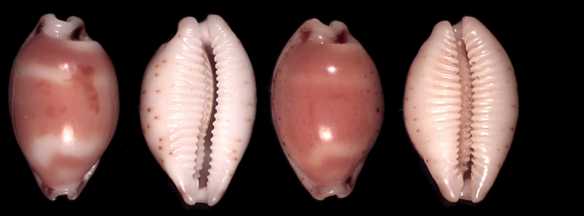
Bistolida hirundo ssp. 1
This form is more globular, with a different dentition and rostrate extremities. The shape resembles ursellus, but these are definitely some strange form of hirundo. We have several fresh shells and many subfossil ones (mostly eroded), but no livecollected sample. Perhaps it constitutes an extinct form.
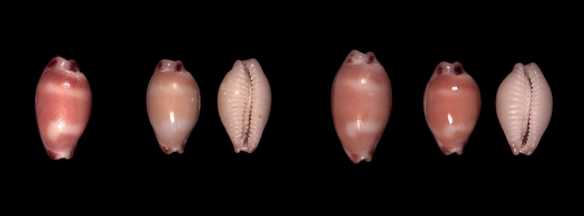
Bistolida hirundo ssp. 2
Then there is a dwarf, slender form resembling Pacific hirundo rouxi from Micronesia. These shells have strong teeth and a more discrete dorsal zonation. The specimens we found are all subfossil, from a village called Gandara.
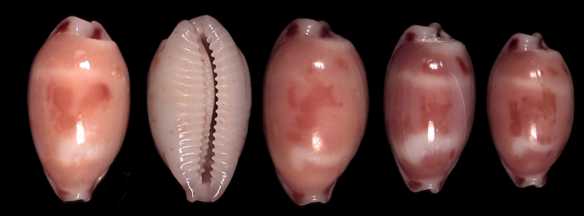
Bistolida hirundo cf. francisca
Yet another surprise to us was the probably presence of h. francisca in southern Sri Lanka. This subspecies resembles a subfossil hirundo but is more slender, with long teeth and a characteristic dorsal zonation. We have several beached specimens, but also a live collected one, retaining the animal.
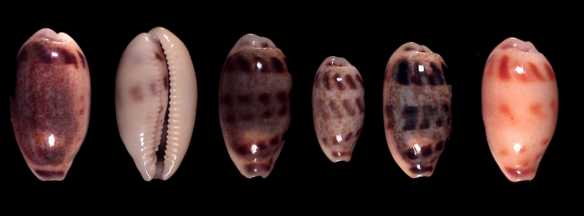
Blasicrura interrupta
Next to ocellata, this is the characteristic cowry of Sri Lanka. it is found all along the south coast, in many variations of banding and callousity. There is also an attractive subfossil form.

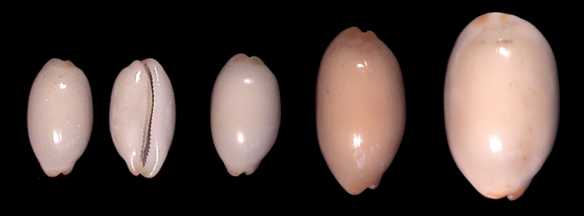
Luria isabella
Of course, the cosmopolitan isabella also occurs in southern Sri Lanka, but much rarer than elsewhere. We have got a giant specimen of 40 mm. More common as a beached shell is a ?new dwarf variety resembling the Pacific isabella gilvella (bottom row). It measures 13 to 17 mm and is rather callous. Surprisingly, only one subfossil shell was found.
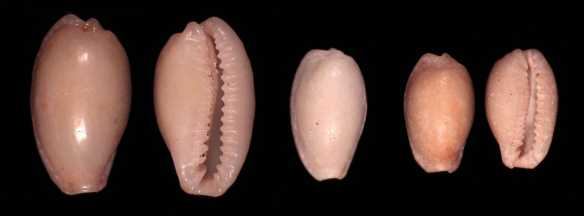
Erosaria labrolineata
Very rare, only few very eroded shells were found.
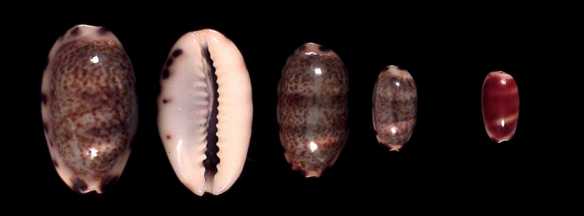
Erronea listeri
One of the most common species in very shallow water. Small, narrow and larger, callous forms occur. There are no subfossil specimens, but a reddish-brown variant is found in an area called "Blowhole" west of Tangalla.

Lyncina lynx
Rather common in shallow water. Sri Lankan shells are usually small, rather slender and heavy. There is a larger, attractive subfossil variant from the Dikwella-deposits.
Palmadusta lentiginosa
A single eroded but typically shaped shell was collected on a beach near Galle. (See plate of turdus)

Leporicypraea mappa geographica
This sought after species is rarely found by divers off Hikkaduwa, a single shell was found in Galle during our stay. It is dark and callous, with a rose coloured base.
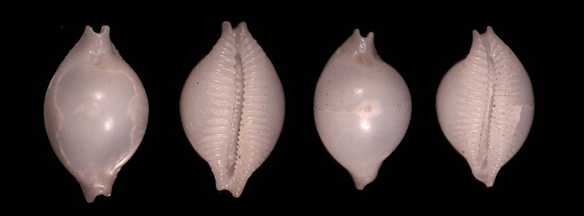
Pustularia margarita
Very few badly eroded samples of this species were found amongst small Trivia and cicerculas collected by children on a beach south of Galle. These shells are rather small and rostrate, different from those of other Indian Ocean localities.
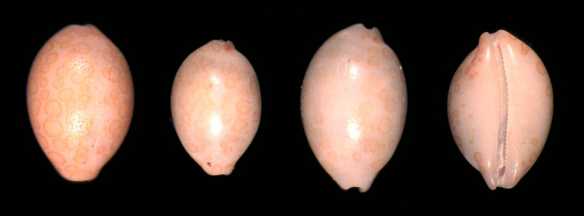
Annepona mariae
The occurrence of this species in the Indian Ocean was reported for Mauritius and Tanzania, the findings in the south of Sri Lanka widen the range to the north. About a dozen eroded shells were found on the beach of Tangalla. These are rather small (13-16 mm) and selnder, with small orange rings.
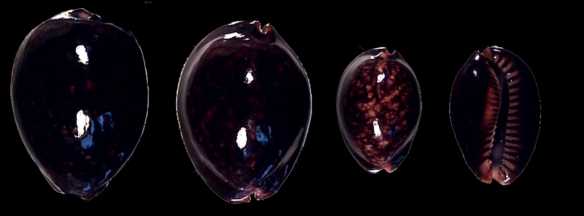
Mauritia mauritiana
There are some rocky cliffs close to the shore near Tangalla. In the vicinits, fishermen offer fresh specimens of mauritiana for sale. These are small, with dense dorsal pattern. Their surface is badly scratched. In Weligama, we managed to obtain two deep black melanistic specimens.
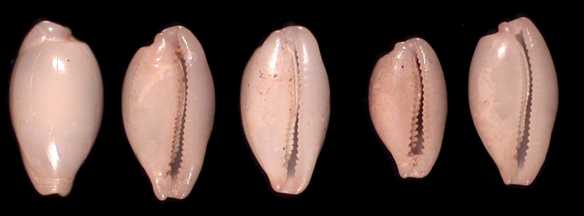
Purpuradusta microdon chrysalis
Eroded shells occasionally wash up on the beaches of Weligama and Tangalla. These resemble the Indian Ocean variety chrysalis by being rather large (11-14 mm) and slender.
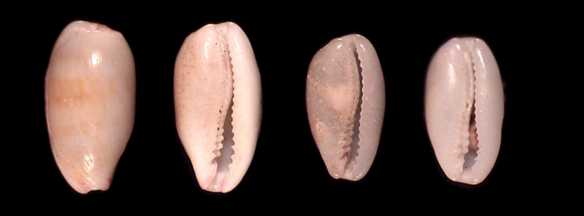
Purpuradusta minoridens
The presence of minoridens in the Indian Ocean was claimed by Burgess but I had doubts that the shells were correctly identified. Now I confess that I was wrong in this point. About a dozen eroded but typical minoridens were found amongst beachgrit in various places.
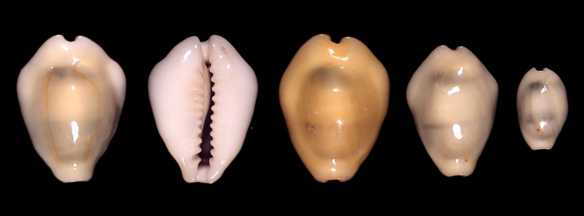
Erosaria moneta moneta
On rocky tidal flats, moneta is a common species. In Sri Lanka it resembles specimens from the Maldives and India. There is also a dwarf form and the usual range of variations.
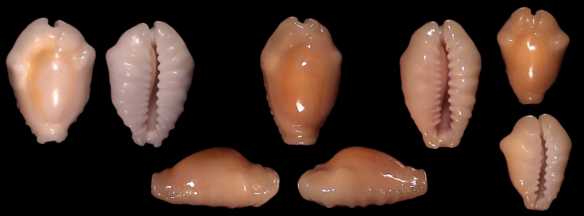
Erosaria moneta ssp. nov. an extinct subspecies
In an area near Tangalle, a spectacular variant occurs: The teeth are extending across the margins toward the dorsum, forming distinct marginal pitting. This feature is not found in any other population of moneta. The strange pitted shells are only found subfossil, but we have a few in excellent condition. They are more spectacular than the photos actually reveal. The pitting is an important systematic feature of the genus Erosaria. In all moneta formerly known, this feature was missing. The fact that a population of moneta with distinct marginal pitting once existed in Sri Lanka confirms the relationship of the moneta-group with typical Erosaria.

Staphylaea nucleus
The northern Indian Ocean nucleus was separated as ssp. sturanyi by Schilder & Schilder. We have found shells correcponding with their description. These are more rostrate, with a bent aperture. We also found an extremely large (32 mm) specimen in Tangalla. Livecollected shells are, however, rare.
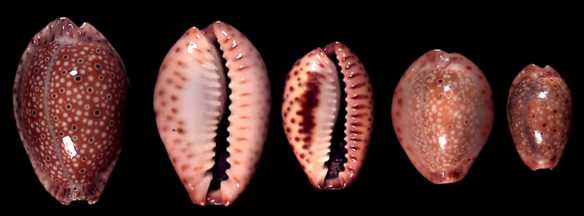
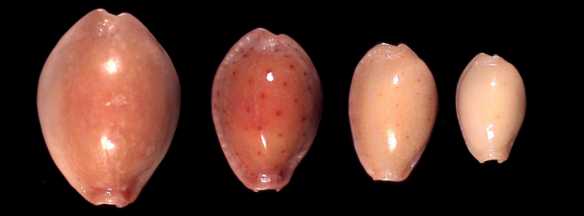
Erosaria ocellata
The most beautiful of the Sri Lanka Cowries, may be of all cowries. A wide range of variations can be found along the coast in the south, and on our way between Weligama and Tangalla we hit a spot with two notable variations. One has a black blotch on the base (a form rarely seen also in ocellata from India), the other is a spectacular subfossil form which has raised a lot of confusion amongst collectors in the past, as it may look completely different from the typical ocellata and is available in gem condition.
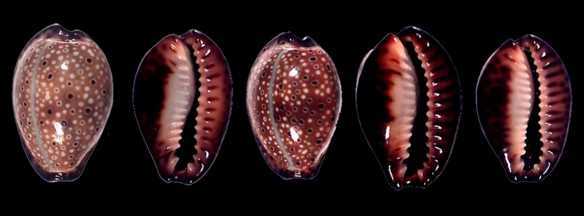
Erosaria ocellata var. nov.
In the area of Tangalla, a beautiful variation occurs on muddy bottom at 10-15 m. It is found in the vicinity of the habitat of Lyria cloveriana. In this form of ocellata the margins are very dark to completely black, there is a large basal blotch and the base is dark orange. We have found quite a few samples so that we can say it is not a variation just by chance. Similar shells have not been found in other areas.
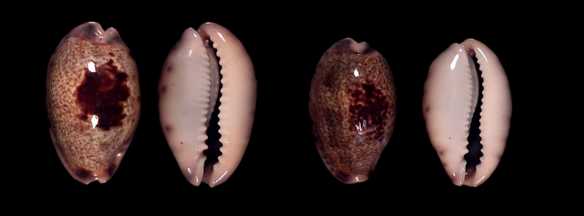
Erronea pallida
Rare in the south, a few dead and two livecollected specimens were found in the Galle area.
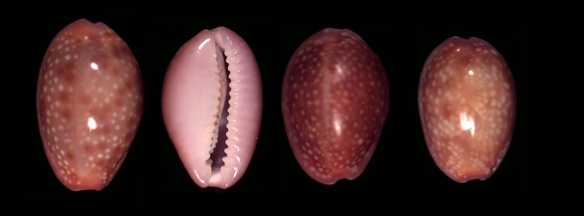
Erosaria poraria
This otherwise common species was found only by a few beached samples. These are smaller, more slender and paler than specimens from India or the Maldives.
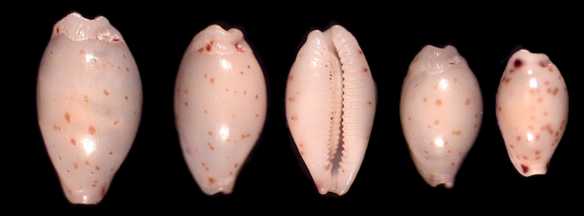
Notadusta punctata var.
Common as a beached shell, but no live specimens were found. The posterior of the Sri Lanka shells is greatly calloused and indistinctly ribbed. This phenomenon is known from a few other localities such as the Solomons and some Philippine places. In the Sri Lanka shells, its development is particular well. It should be mentioned that the size of the shells found varies extremely, between 9 and 19 mm in a single locality.
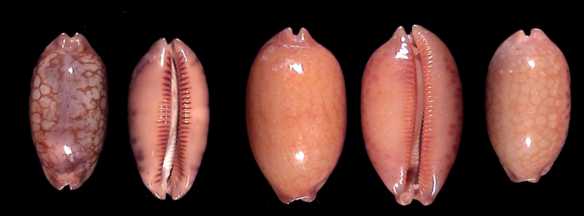
Mauritia scurra indica
Very rare as a living shell (we got just one otherwise typical specimen), but two spectacular subfossil specimens of huge size and high quality rewarded our search.
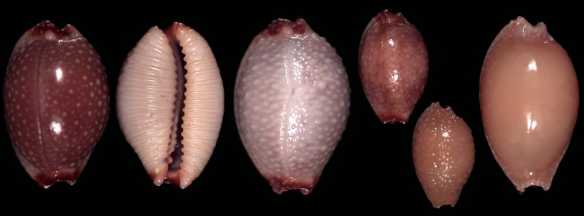
Staphylaea staphylaea staphylaea and its formae
A common species, but always found beached. There are three variations. A large, typical form representing the typical staphylaea as to be expected in this part of the world. It comes in a smooth and a pustulose variation. A second, dwarf form with short extremities, coarse teeth and reduced dorsal pustules, and a third "spiny" variety that at glance looks subfossil but we have three spoecimens with remnants of a bright red animal. It does not have darker tips, the pustules are coarse, the extremities very rostrated. It is also smaller than staphylaea. A subfossil form of staphylaea is larger and often smooth, we got quite a few samples of this as well. Perhaps just like in the case of hirundo, the complete absence of a related competitor (limacina) in southern Sri Lanka has enabled staphylaea to evolve more formae than elsewhere.
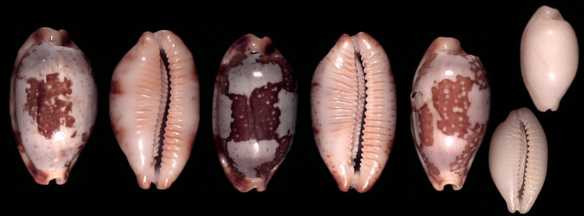
Bistolida stolida rubiginosa
An attractive but rare subspecies, known mainly by eroded specimens. There is a dwarf variety in the area of Galle, and a subfossil form from the Dikwella-deposits.
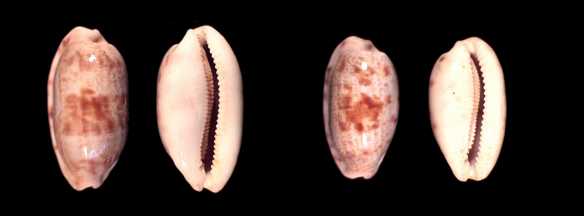
Blasicrura teres pellucens
Quite rare, in fact we got only two livecollected shells and a few beached ones. These do not differ form specimens of other localities.
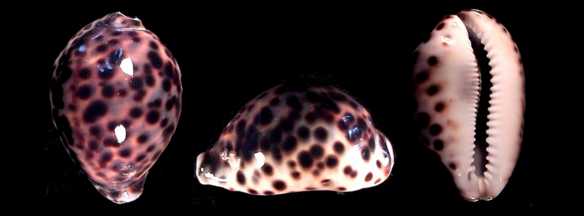
Cypraea tigris
Moderately common in the Galle area, according to a local dealer. We cannot claim that this is true, the illustrated shell is the only sample we saw. Some other tigris that came along our way in western Sri Lanka were imported from the Philippines.
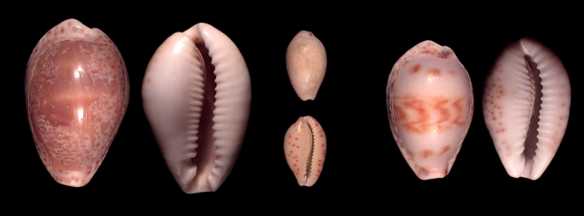
Erosaria turdus
The beached specimen shown here (left) is the only evidence of turdus in southern Sri Lanka. We found it on our 1998-trip. In the middle: P. ziczac, right: P. lentiginosa, two more specimens we have only a single sample of.
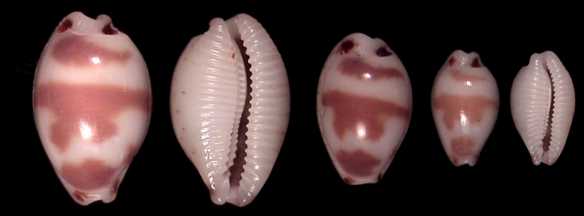
Bistolida ursellus
The specimens we found were all eroded, but some of them had distinct posterior ribbing, thus revealing the identity as ursellus. A larger and a dwarf form occur alongside.
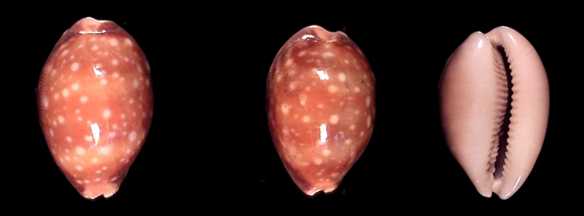
Lyncina vitellus
A common species in the sublitoral. We found several empty specimens amongst coral rubble. The Sri Lanka specimens are rather heavy and pale, with a distinct marginal frame.
Palmadusta ziczac
A single eroded shell was found amongst other beachgrit collected between Weligama and Tangalla. (See plate of turdus, middle)
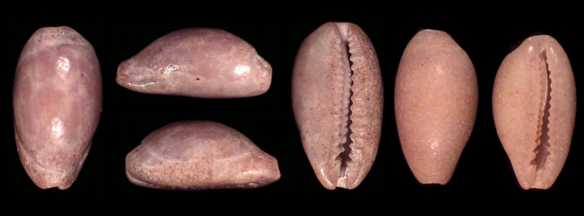
(Genus indet.) species nova 1
Two specimens of an undescribed species are available, (13 and 15 mm) in which the dentition resembles Blasicrura (Talostolida), but with a coarser fossula. The shape is elongate-oval, with produced extremities. The two eroded shells could not be assigned to any known species, the generic determination is pending.
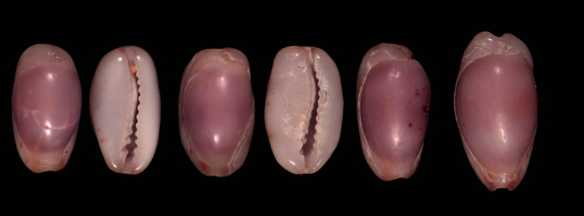
(Purpuradusta) species nova 2
Several worn specimens of a very small (7-10 mm) species with a cylindrical body and greatly produced extremities was discovered at Dondra Head, the southernmost tip of Sri Lanka. The extremities are faintly tinted with brown, suggesting an accomodation in Purpuradusta. the coarse dentition with a steep fossula hints at a certain relationship to gracilis.